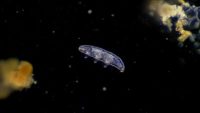“Links to part 1 and part 2 if you haven’t read them.” Admin How were speleothem growth variables affected by Noah’s Flood and its aftermath? …read more Source: creation.com
Three long ice cores have been drilled and extracted from the East Antarctic ice sheet: the EPICA Dome C, Vostok, and Dome Fuji cores. Secular scientists have assigned ages to the bottoms of these cores: 800 thousand, 400 thousand, and 720 thousand years, respectively. Now, six international teams hope to drill a fourth deep ice core in East Antarctica, one with bottom ice labeled as 1.5 million years old. Because of concerns over global warming,… More… …read more Source: icr.org
“Watch part 1 here if you haven’t.” Admin What variables affect the growth rate of speleothems? …read more Source: creation.com
By Ken Ham “Newly discovered sponge-like animals could change the known history of animal evolution.” Claims like this are ones we often hear—the evolutionary story and timeline are constantly changing as new finds upset everything they thought they knew, such as when animals first evolved from sponges (if they even evolved from sponges—that’s much debated in the evolutionary community!). Now, some will claim this is just how science works. After all, our knowledge about the natural world adjusts as we make new discoveries. But it’s interesting to note how frequently this happens with the idea of evolution—timelines that were “settled [More]
“This is the first of a great 5 part series on Flood geology featuring geologist Steve Austin. There are links to the other parts on the videos page.” Admin In 1980 Mount St. Helens erupted and quickly became known as “God’s gift to Creationists.” Thirty years later geologist Dr. Steve Austin returns to the volcanic monument to share about the catastrophic processes which reshaped the terrain and how they support the Biblical record of earth’s history. He presents his research on how the events at Mount St. Helens reveal catastrophic processes in other geologic features such as the Grand Canyon [More]
The Great Unconformity is one of the most baffling mysteries in the geological sciences.1 It is marked by a massive surface of erosion that appears all over the world at about the same time. Many studies have tried and failed to satisfactorily explain its global occurrence. Now a new report published in Geology claims to take a step forward in solving this mystery.2 Just like prior attempts, this research effort sti… More… …read more Source: icr.org
How can Noah’s Flood explain it? …read more Source: creation.com
How biblical geology interprets our world to add insights, reveal problems, and solve puzzles. …read more Source: creation.com
How does the Mount Pinatubo eruption support Flood geology? …read more Source: creation.com
Showing how cave structures don’t always form by ‘slow and gradual’ processes. …read more Source: creation.com
Evolutionary scientists from the Chinese Academy of Sciences in Beijing and several universities in the United States, Italy, and Japan have recently claimed the Earth’s axis tilted about 12 degrees in the Late Cretaceous.1 Geological research at ICR shows that the rocks identified as Cretaceous were deposited about the high water point of the Flood, on Day 150.2 While it is possible the Earth tilted significantly duri… More… …read more Source: icr.org
Scientists have found genetic evidence suggesting that legume trees emerged from separate African tree populations during the Ice Age.1 This conclusion is consistent with the creation model of a post-Flood Ice Age. Lead researcher Dr. Rosalía Piñeiro of the University of Exeter was quoted as saying, We examined the DNA of five legume trees, which are found widely in Africa… More… …read more Source: icr.org
Does recent modelling solve the long-age problems with Io? …read more Source: creation.com
By Dr. Elizabeth Mitchell “There is a book . . .” Ken Ham reminded Nye at their 2014 debate, and the Bible’s history is history we can trust. …read more Source: AIG Daily
Amazingly preserved trilobite fossils testify to rapid fossil formation during Noah’s Flood …read more Source: creation.com
By Ken Ham Tardigrades (also known as water bears) are famous for their ability to survive nearly anything, including the vacuum of space. Evolutionists believe these microscopic animals have survived for 540 million years, and yet, partially due to their size, only three fossil specimens have been uncovered. The third tardigrade specimen—described as a “once-in-a-generation” find—was only just discovered, preserved incredibly beautifully in a piece of amber dated at supposedly 16 million years. As many amber fossils are, this tardigrade was so well preserved that scientists could observe fine details: Researchers say the pristine specimen is the best-imaged fossil tardigrade [More]
What are the odds that a buried animal would still have intact DNA after 125 million years? Researchers publishing in the journal Communications Biology said exactly that.1 But it’s what they elected not to say that tells just as big a story. The cartilage-containing fossil named Caudipteryx came from China’s famous Jehol Biota. Although the study authors along with most scientists lab… More… …read more Source: icr.org
By Ken Ham You may have seen exciting headlines like this one: “3D scans show boat-like formation matching ‘biblical’ description of Noah’s Ark, archaeologists say.” According to reports, researchers using ground-penetrating radar have discovered a boat-shaped formation matching the dimensions of the biblical ark, including “parallel lines and right angles,” on Mount Tendürek in Eastern Turkey. Could it be true—has Noah’s ark been found? Well, this isn’t a new find—this is the Durupinar site we’ve written about many times before (for example here, here, and here). It was first postulated as an Ark site back in 1959 and has been [More]
Evolutionists cannot challenge creationists to explain the order in the fossil record, since that order appears to be far from established. …read more Source: creation.com
By Dr. Andrew A. Snelling Beneath the surface of Yellowstone’s beauty lie fearful clues to the past—and a possible future. …read more Source: AIG Daily
The Great Unconformity is one of the most baffling mysteries in the geological sciences.1 It is marked by a massive surface of erosion that appears all over the world at about the same time. Many studies have tried and failed to satisfactorily explain its global occurrence. Now a new report published in Geology claims to take a step forward in solving this mystery.2 Just like prior attempts, this research effort sti… More… …read more Source: icr.org
How does the biblical framework explain a wet, lush Sahara in the past? …read more Source: creation.com
An encounter at a dinosaur park underscores the importance of letting the Bible’s history transform our lives …read more Source: creation.com
How Noah’s Flood solves long standing geological puzzles …read more Source: creation.com
By Ken Ham Over the summer we announced ground-breaking research from staff geologist Dr. Andrew Snelling. Dr. Snelling—a world-class geologist with a PhD from the University of Sydney—has been doing research in the Tapeats Sandstone formation in the Grand Canyon that evolutionists have never done—and have even tried to stop Dr. Snelling from doing—because of their worldview of millions of years. But because Dr. Snelling starts with the Word of God, he has a totally different worldview of interpreting the Grand Canyon . . . and what he’s found, using observational science, has confirmed exactly what we’d expect by starting [More]
What was the pre-Flood continental configuration? …read more Source: creation.com
By Ken Ham “Ugly diamonds”—or fibrous diamonds—aren’t the kind you’re likely to see on a lady’s finger, but you might find them in a scientific laboratory. Some of these cloudy diamonds contain small pockets of fluid, believed by many geologists to be billions of years old and therefore supposedly able to give us insight into early earth. But where do these dates come from? Well, a popular summary of some new research on these fibrous diamonds states, By modeling [the] decay [of uranium and thorium] and how much helium 4 leakage is possible over time, Weiss and his colleagues determined [More]














































